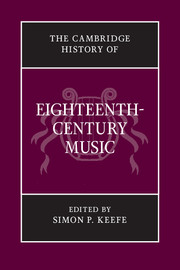Book contents
- Frontmatter
- PRELUDE
- PART I MUSIC FOR THE CHURCH
- INTERLUDE
- PART II MUSIC FOR THE THEATRE
- INTERLUDE
- PART III MUSIC FOR THE SALON AND CONCERT ROOM
- 16 Keyboard music from Couperin to early Beethoven
- 17 The serenata in the eighteenth century
- 18 Private music in public spheres: chamber cantata and song
- 19 Handel and English oratorio
- 20 The overture-suite, concerto grosso, ripieno concerto and Harmoniemusik in the eighteenth century
- 21 Concerto of the individual
- 22 Eighteenth-century symphonies: an unfinished dialogue
- 23 The string quartet
- POSTLUDE
- Appendix I Chronology
- Appendix II Institutions in major European cities
- Appendix III Personalia
- Index
- References
16 - Keyboard music from Couperin to early Beethoven
from PART III - MUSIC FOR THE SALON AND CONCERT ROOM
Published online by Cambridge University Press: 28 March 2011
- Frontmatter
- PRELUDE
- PART I MUSIC FOR THE CHURCH
- INTERLUDE
- PART II MUSIC FOR THE THEATRE
- INTERLUDE
- PART III MUSIC FOR THE SALON AND CONCERT ROOM
- 16 Keyboard music from Couperin to early Beethoven
- 17 The serenata in the eighteenth century
- 18 Private music in public spheres: chamber cantata and song
- 19 Handel and English oratorio
- 20 The overture-suite, concerto grosso, ripieno concerto and Harmoniemusik in the eighteenth century
- 21 Concerto of the individual
- 22 Eighteenth-century symphonies: an unfinished dialogue
- 23 The string quartet
- POSTLUDE
- Appendix I Chronology
- Appendix II Institutions in major European cities
- Appendix III Personalia
- Index
- References
Summary
Comparing the openings of the sarabande from J. S. Bach’s English Suite No. 2 in A minor and the second movement of Muzio Clementi’s Piano Sonata in A major, Op. 50 no. 1 reveals some striking similarities and differences (see example 16.1a and 16.1b). Clementi appears to have borrowed a good deal from the earlier suite movement, including its key, time signature, thematic substance and sarabande style; but he has strenuously reinterpreted the material within the expanded possibilities of a later keyboard idiom, adorning it with chromaticism and intensifying the texture. These two excerpts, dating from 1715 and 1804–5, respectively, represent the chronological boundaries of this chapter. The comparison evokes, in microcosm, both the degree of stylistic progress that undoubtedly took place in certain areas of solo keyboard music from the time of Couperin to early Beethoven, and the extent to which this progress was circumscribed – or stimulated – by earlier stylistic models.
The sound world of Clementi’s slow movement exploits the sonorous possibilities of the English piano that he would undoubtedly have had at his disposal at this stage of his career. Developments in the manufacture and distribution of keyboard instruments were certainly a major stimulus for (and indirect consequence of) stylistic change in eighteenth-century keyboard music, but such a strenuous recreation of an earlier style must also be attributed to broader changes in musical culture of the 1780s, 1790s and early 1800s.
- Type
- Chapter
- Information
- The Cambridge History of Eighteenth-Century Music , pp. 455 - 491Publisher: Cambridge University PressPrint publication year: 2009



